- Home
- About
- Map
- Trips
- Bringing Boat West
- Migration West
- Solo Motorcycle Ride
- Final Family XC Trip
- Colorado Rockies
- Graduates' XC Trip
- Yosemite & Nevada
- Colorado & Utah
- Best of Utah
- Southern Loop
- Pacific Northwest
- Northern Loop
- Los Angeles to NYC
- East Coast Trips
- Martha's Vineyard
- 1 Week in Quebec
- Southeast Coast
- NH Backpacking
- Martha's Vineyard
- Canadian Maritimes
- Ocracoke Island
- Edisto Island
- First Landing '02
- Hunting Island '02
- Stowe in Winter
- Hunting Island '01
- Lake Placid
- Chesapeake
- Provincetown
- Hunting Island '00
- Acadia in Winter
- Boston Suburbs
- Niagara Falls
- First Landing '99
- Cape Hatteras
- West Coast Trips
- Burning Man
- Utah Off-Roading
- Maui
- Mojave 4WD Course
- Colorado River Rafting
- Bishop & Death Valley
- Kauai
- Yosemite Fall
- Utah Off-Road
- Lost Coast
- Yosemite Valley
- Arizona and New Mexico
- Pescadero & Capitola
- Bishop & Death Valley
- San Diego, Anza Borrego, Joshua Tree
- Carmel
- Death Valley in Fall
- Yosemite in the Fall
- Pacific Northwest
- Utah Off-Roading
- Southern CA Deserts
- Yosemite & Covid
- Lake Powell Covid
- Eastern Sierra & Covid
- Bishop & Death Valley
- Central & SE Oregon
- Mojave Road
- Eastern Sierra
- Trinity Alps
- Tuolumne Meadows
- Lake Powell Boating
- Eastern Sierra
- Yosemite Winter
- Hawaii
- 4WD Eastern Sierra
- 4WD Death Valley +
- Southern CA Deserts
- Christmas in Tahoe
- Yosemite & Pinnacles
- Totality
- Yosemite & Sierra
- Yosemite Christmas
- Yosemite, San Diego
- Yosemite & North CA
- Seattle to Sierra
- Southwest Deserts
- Yosemite & Sierra
- Pacific Northwest
- Yosemite & South CA
- Pacific Northwest
- Northern California
- Southern Alaska
- Vancouver Island
- International Trips
- Index
- Tips
- Books
- Photos/Videos
- Search
- Contact
Galapagos - Genovesa Island, Ecuador
Saturday, March 18, 2023 - 9:00am by Lolo
0 miles and hours from our last stop - 1 night stay
Travelogue
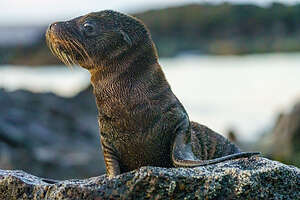 Galapagos Fur SealWhile we slept to the gentle rocking of the boat, our trusty captain made the 8-hour passage north from North Seymour Island to Genovesa (Tower) Island, the northernmost and most remote of the islands we would visit. In fact, sometime during the night, we went over the bump (equator) back into the northern hemisphere.
Galapagos Fur SealWhile we slept to the gentle rocking of the boat, our trusty captain made the 8-hour passage north from North Seymour Island to Genovesa (Tower) Island, the northernmost and most remote of the islands we would visit. In fact, sometime during the night, we went over the bump (equator) back into the northern hemisphere.
Genovesa is known for its abundant birdlife, notably the world’s largest colony of red-footed boobies, with more than 100,000 pairs coming to nest each year.
Oddly, there are no land reptiles on this island, just a few small marine iguanas. This is attributed to the direction of the ocean currents, which wouldn’t have carried terrestrial animals here.
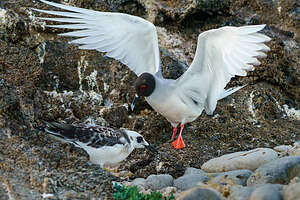 Swallow-tailed gull and her youngWe woke up (at 4:45 of course) safely anchored in Darwin Bay, inside a volcanic caldera surrounded by cliffs.
Swallow-tailed gull and her youngWe woke up (at 4:45 of course) safely anchored in Darwin Bay, inside a volcanic caldera surrounded by cliffs.
After breakfast, we promptly got into the panga at 5:50 to be dropped off on a small beach where colonies of great frigatebirds and red-footed boobies nest. This was our first wet landing, which meant we had to wear the appropriate footwear (Tevas in my case) because we would not be brought all the way to shore, but close enough to easily get ashore.
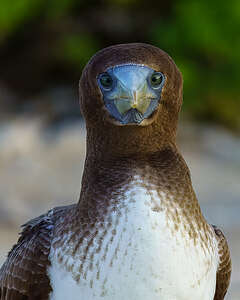 Juvenile booby of sorts?Today we were greeted by one old friend, the adorable fur seal we met yesterday on North Seymour Island, and one new, the lovely swallow-tailed gull.
Juvenile booby of sorts?Today we were greeted by one old friend, the adorable fur seal we met yesterday on North Seymour Island, and one new, the lovely swallow-tailed gull.
I spoke yesterday about the fur seal and how they somewhat inadvertently found their way to the Galapagos Islands during the Ice Age and couldn’t leave when the glaciers melted. However, like all good Galapagos residents, they adapted and learned to cope in a climate not conducive to having a double furry coat of insulation.
The swallow-tail gull is a beautiful bird with a pearly gray and black head, pinkish legs, and a pale-tipped bill with a white spot at the base. When in flight they have a distinctive three-tone wind pattern of gray, white, and black.
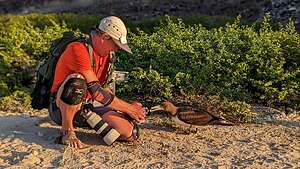 Herb and a very curious Brown NoddyThe ones we saw also had a distinctive red ring around their eyes, which means they are ready to breed. If the ring is black, they are not in the mood. Since they only come to the Galapagos when they are breeding, all of them on Genovesa had the red ring.
Herb and a very curious Brown NoddyThe ones we saw also had a distinctive red ring around their eyes, which means they are ready to breed. If the ring is black, they are not in the mood. Since they only come to the Galapagos when they are breeding, all of them on Genovesa had the red ring.
When swallow-tailed gulls are not breeding, they are totally pelagic, flying and hunting over the open ocean, never once setting their webbed feet on dry land. Although they spend most of their life flying and hunting over the open ocean, when it’s time to breed they come to the Galapagos Islands, particularly the rocky shores and cliffs of Genovesa (Tower), Hood, and Wolf islands.
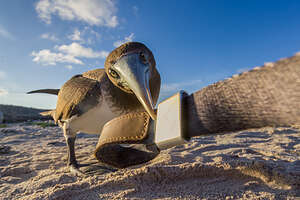 Brown Noddy peering in Herb's lensAnother interesting fact about the swallow-tailed gulls is that they are the only fully nocturnal seabird in the world, using their highly developed night vision to prey on squid and small fish which rise to the surface at night to feed on plankton.
Brown Noddy peering in Herb's lensAnother interesting fact about the swallow-tailed gulls is that they are the only fully nocturnal seabird in the world, using their highly developed night vision to prey on squid and small fish which rise to the surface at night to feed on plankton.
Since the Galapagos is a great place to study how animals have evolved over time to cope with their environment, it’s important to point out that their night hunting is a form of adaptive behavior, evolving from the greater abundance of squid and other fish on the surface at night and the necessity of bringing food back safely before the diurnal frigatebird can steal it from them.
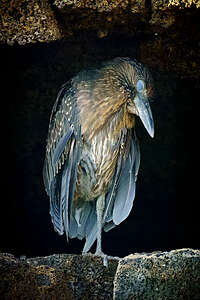 Yellow-crowned night heronFrom the beach, we set off on a 1.5 km trail which would take us inland to the mangroves where the red-footed boobies nest.
Yellow-crowned night heronFrom the beach, we set off on a 1.5 km trail which would take us inland to the mangroves where the red-footed boobies nest.
We didn’t get too far before we met a very social and curious Brown Noddy (or at least I think that’s what he was), who was even more interested in us than we were in him. As Herb knelt down to his eye level, the Noddy actually stuck his beak right into Herb’s lens, which did make for a very interesting perspective. He then started playing with Herb’s camera strap, trying to pull it away from him. He also nibbled on Monica’s toes for a while.
He was so much fun to play with that we found it hard to pull ourselves away. Unlike the non-photo tour groups which tended to just march non-stop along a trail, we would literally spend 2 hours just observing and photographing the wildlife, spreading ourselves out like beads on a necklace with Monica up front and Tui in the rear.
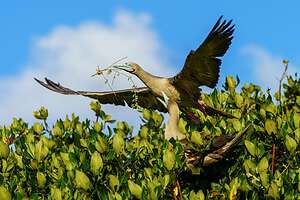 Male red-footed booby bringing twigs to nestIt was slow-going getting to the mangroves, because we kept seeing so many interesting creatures along the way, such as the nocturnal yellow-crowned night heron, snoozing on a rocky ledge. We were curious about the membrane across his eye, but later learned that many water birds have an extra eyelid, called the nictitating membrane, which provides protection to the eye.
Male red-footed booby bringing twigs to nestIt was slow-going getting to the mangroves, because we kept seeing so many interesting creatures along the way, such as the nocturnal yellow-crowned night heron, snoozing on a rocky ledge. We were curious about the membrane across his eye, but later learned that many water birds have an extra eyelid, called the nictitating membrane, which provides protection to the eye.
Finally, in the mangroves, we got our first sighting of red-footed boobies, with their bright red feet and colorful light blue and pink beak. The ones found in the Galapagos are predominantly brown with a white, belly, rump, and tail. Out of the three booby species in the Galapagos, the red-footed boobies are the smallest.
 Red-footed boobyUnlike the blue-footed boobies who mate and nest right out in the open, often right in the middle of a trail, the red-footed boobies (males) collect twigs and build nests in trees and shrubs. They have longer toes than other boobies which allows them to grasp branches.
Red-footed boobyUnlike the blue-footed boobies who mate and nest right out in the open, often right in the middle of a trail, the red-footed boobies (males) collect twigs and build nests in trees and shrubs. They have longer toes than other boobies which allows them to grasp branches.
They are much more difficult to photograph than the blue-footed boobies because there always seems to be a branch in the way, often hiding their faces and red-feet.
However, we were fortunate enough to photograph a male bringing some twigs back to the nest.
 Frigatebird stealing food from a booby mid-airRed-footed boobies are strong flyers and feed on flying fish and schooling squid far out to sea, often traveling 90 miles out when foraging. They are well adapted for diving, with long bills and aerodynamic bodies.
Frigatebird stealing food from a booby mid-airRed-footed boobies are strong flyers and feed on flying fish and schooling squid far out to sea, often traveling 90 miles out when foraging. They are well adapted for diving, with long bills and aerodynamic bodies.
Many visitors to the Galapagos never get to see this interesting sea bird, because they are only found in the northern, more remote part of the Galapagos archipelago, particularly Genovesa and Punta Pitt on San Cristobal Island where fewer people visit.
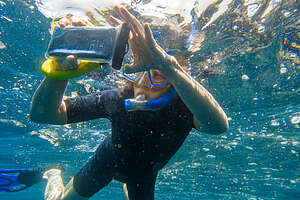 Snorkel Time!On the way back to the panga, we saw two lava gulls nesting on a rocky cliff ledge. They are the second species of gulls on Genovesa, much darker than the swallow-tailed gulls in order to blend better into the lava rocks they nest on.
Snorkel Time!On the way back to the panga, we saw two lava gulls nesting on a rocky cliff ledge. They are the second species of gulls on Genovesa, much darker than the swallow-tailed gulls in order to blend better into the lava rocks they nest on.
However, the most dramatic action we encountered was a frigatebird doing its pirate-thing. As I mentioned in the North Seymour writeup, frigatebirds can’t get wet, because their preen gland doesn’t produce enough oil to waterproof their wings. So, they have to be pirates, surviving by stealing food from other diving birds (usually blue-footed boobies), by grabbing their tail feathers and shaking them violently until they give up their catch.
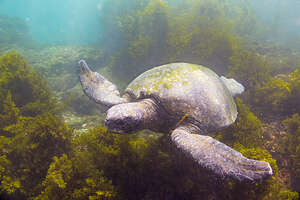 Galapagos Sea TurtleWhat an exciting day! Wait a minute, it was only 9:00 am, and we were just getting started. Next up, snorkeling in Darwin Bay.
Galapagos Sea TurtleWhat an exciting day! Wait a minute, it was only 9:00 am, and we were just getting started. Next up, snorkeling in Darwin Bay.
This was to be the first of many snorkeling adventures this trip (one each day and sometimes even two). Herb and I had purchased new 2mm shorty wetsuits for the trip, which turned out to be the perfect thickness for the warm waters of March.
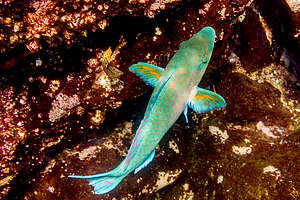 Rainbow ParrotfishIn order not to lose any clients, the following safety measures were used. The two pangas from our boat would stay out either ends of us, and the panga drivers would constantly count heads, making sure we were all accounted for. Meanwhile, Monica and Tui would be in the water keeping an eye on us as well. Monica even had a lifesaving ring with rope around it to hold onto in case any of us needed a break or had to adjust a facemask. While I didn’t hang onto it, I did pretty much follow Monica around in case I had to.
Rainbow ParrotfishIn order not to lose any clients, the following safety measures were used. The two pangas from our boat would stay out either ends of us, and the panga drivers would constantly count heads, making sure we were all accounted for. Meanwhile, Monica and Tui would be in the water keeping an eye on us as well. Monica even had a lifesaving ring with rope around it to hold onto in case any of us needed a break or had to adjust a facemask. While I didn’t hang onto it, I did pretty much follow Monica around in case I had to.
I had bought a waterproof cover for my phone so that I could take pictures, but it didn’t work very well, so I left Herb in charge of underwater photos. In retrospect, I wish we had a GoPro, like many of the other people on the trip, as videos would have been nice to have.
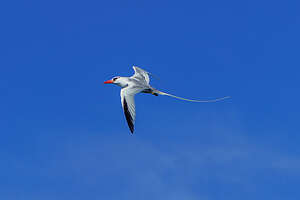 Red-billed tropicbird in flightThat day we saw dolphins, sea turtles, sting rays, and very colorful reef fish. The hour passed by before we knew it.
Red-billed tropicbird in flightThat day we saw dolphins, sea turtles, sting rays, and very colorful reef fish. The hour passed by before we knew it.
Then it was back to the mothership where we had a delicious lunch and time for a far too brief nap before heading out on the panga again to climb Prince Philip’s Steps.
Along the way Herb was able to capture a red-billed tropicbird in flight from, which are rarely seen from land, as they nest in the crevices of the rocky cliffs. Adults have a stout red bill and long white tail streamers. They are absolutely beautiful.
The Prince Philip Steps were named in honor of a royal visit to the islands by Queen Elizabeth II’s husband Philip. The steep-railed stairway leads to a dramatic trail along the lava plains atop the cliffs.
 Prince Philip’s stepsAs if we hadn’t already seen such an amazing collection of wildlife today, there was more.
Prince Philip’s stepsAs if we hadn’t already seen such an amazing collection of wildlife today, there was more.
We saw a fuzzy baby chick emerging from its nest (not sure if it was a red-footed or masked booby chick). It looked like it had just been born.
Although we had seen Magnificent frigatebirds on North Seymour, here we came across a tender moment where the male and female are actually cuddling. It’s difficult to see, but the female is resting her head on her mate’s inflated, red throat pouch.
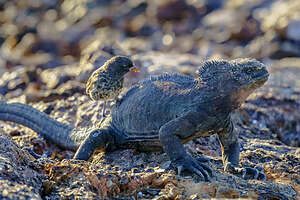 Marine Iguana giving a Vampire Finch a piggy back rideWe also got to see our first marine iguana with a vampire ground finch on his back. I won’t go into depth now describing the marine iguana’s appearance, behaviors, etc., because we would be seeing much larger populations of them when we visited Fernandina, Floreana, and Espanola; however, the vampire finch was a rare find.
Marine Iguana giving a Vampire Finch a piggy back rideWe also got to see our first marine iguana with a vampire ground finch on his back. I won’t go into depth now describing the marine iguana’s appearance, behaviors, etc., because we would be seeing much larger populations of them when we visited Fernandina, Floreana, and Espanola; however, the vampire finch was a rare find.
Everyone knows about Darwin’s discovery of how finches adapted and evolved differently on each of the Galapagos islands based on the available food source. Well, that’s how the finches on Genovesa became vampires. As seeds and insects are sometimes scarce on the northern islands, these finches evolved to have extremely sharp beaks, which they use to peck at the feathers and skin of Nazca and blue-footed boobies until blood is drawn, which they then drink.
 Galapagos short-eared owlTheir beaks might be sharp, but not sharp enough to penetrate the skin of a marine iguana, so I think he was just going for a joy ride.
Galapagos short-eared owlTheir beaks might be sharp, but not sharp enough to penetrate the skin of a marine iguana, so I think he was just going for a joy ride.
The last bird of an already eventful day was a short-eared owl, a medium-sized brownish bird, only found on Genovesa Island. He was asleep on his perch, although they, unlike other owls, do sometimes hunt during the day. We especially took note of his hairy legs.
What a day! Now it was back to the boat, a briefing as to tomorrow’s activity, dinner, and bed.
Recap of creatures we saw today: fur seals, swallow-tailed gulls, lava gulls, brown noddies (I think), juvenile blue-footed booby (?), red-footed boobies, yellow-crowned night heron, frigatebirds, sea turtles (underwater), red-billed tropicbird in flight, vampire ground finch, marine iguana, and a Galapagos short-eared owl
- ‹ previous
- 4 of 13
- next ›
Galapagos - Genovesa Island location map in "high definition"
Javascript is required to view this map.
